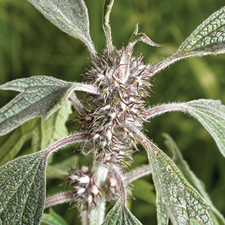Tried & True Toughies
04 Jul 2010
It’s hard to love plants that die off, never produce or need constant babying. Sometimes you gotta give your plants “tough love,” and let ’em figure it out on their own.
Here are some that thrive on tough lovin’.
By Panayoti Kelaidis As senior curator at Denver Botanic Gardens, I always hear the same complaint: it’s hard to grow things here. Between temperature swings, the soil and not much moisture, what’s a gardener to do? Well, when the going gets tough, the tough get going—-and that applies to gardening, too. My recommendation is to grow tough-lovin’ plants like natives that are naturally adapted to Front range conditions. When the weather swings 60 degrees in a day, when the days are sweltering without a hint of rain, when the soil is depleted and compacted, that’s when tough-lovin’ plants get going. Here, then, are my picks for plants that love it tough—and still strut their stuff in beauteous splendor:BAKER’S TULIP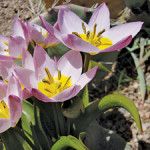
Latin name: Tulipa bakeri Height: 8 inches Spread (once established): 12 inches Bloom season: April-May Bloom color: pink and yellow
Even if this plant were not endemic to the island of Crete (where both my parents were born), I’d still think it was special. There are so few flowers that blend its melting lilac-pink color with a yellow center. And there are never enough bulbs in Colorado gardens. this one actually sends out runners that create quite a patch. it’s hard to go wrong with tulips!
PRAIRIE SNOW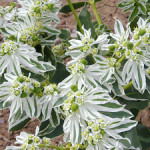
Latin name: Euphorbia marginata Height: 18-30 inches Spread (once established): 12-18 inches Bloom season: July to frost Bloom color: white and silver
This photo of prairie snow (also called snow on the mountain) was taken in late summer off the Denver-Boulder turnpike, where this native wildflower often puts on a terrific show. the year I photographed it, this plant made an almost spherical dome of hundreds of flowers that was amazing. the genus euphorbia is among the largest in the world, with more than 1,000 species—an astonishing number of which make wonderful garden plants.
Prairie snow, our showiest native species, is rather local nowadays. But in the days of the buffalo it must have been widespread. this annual seems to like the disturbance of a million buffalo hooves, as it thrives on churned-up ground, which may explain why it grows on the verges of a highway. it’s been a cherished garden plant for more than 100 years, and you can buy the seeds commercially (don’t collect them from rare, wild stands—they need every seed to perpetuate). Just scatter the seed where you want this plant to grow; it does especially well in veggie-type conditions or even watered perennial gardens.
GIANT YELLOW FOXGLOVE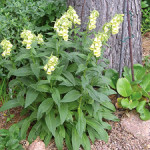
Latin name: Digitalis fontanesii Height: 20-30 inches Spread (once established): 12 inches Bloom season: Late April-June Bloom color: Yellow
The common English foxglove (Digitalis purpurea) used to be the only foxglove sold in the Front range area, which is ridiculous because, albeit lovely, it’s the only one in this genus that needs heavy watering. Giant yellow foxglove is obviously closely related to the large-flower foxglove, Digitalis grandiflora, which is also yellow. there’s something a bit more compact and svelte about giant yellow foxglove, though. it blooms for much of May and June, and later produces wonderful seedpods as well as attractive, evergreen rosettes year-round. this plant has thrived for upward of 10 years in my garden with little fuss or bother.
HARRIMAN’S YUCCA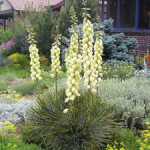
Latin name: Yucca harrimaniae Height: 15-45 inches Spread (once established): 12-24 inches Bloom season: April to June Bloom color: Ivory white
Yuccas are generally acknowledged as among the toughest and most dramatic landscape plants available in colorado—gone are the days when people winced and poked fun at “cactus-and- yucca xeriscapes.” sophisticated gardeners recognize that these two plants yield our most spectacular and rewarding garden displays—for those who know to keep them dry and mulch with gravel.
Although many tree-form yuccas are quite popular—and rightly so—Harriman’s yucca is the tiniest yucca that abounds in western colorado, and it’s my personal favorite. it produces a narrow column of ivory flowers two to three weeks prior to our native yucca, Yucca glauca. the basal tuft of foliage is very compact, and the plant elicits comment and interest year-round. it is surely one of our native treasures.
KOREAN FEATHER REED GRASS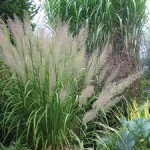
Latin name: Calamagrostis brachytricha Height: 24-40 inches Spread (once established): 12-15 inches Bloom season: August to frost Bloom color: Bronzy gold
Selected for promotion by Plant select in 2008, this graceful grass is an autumn standout at Denver Botanic Gardens. unlike its stiff cousin, Calamagrostis acutiflora ‘Karl Foerster’, which turns straw-yellow in the middle of summer, Korean feather reed grass stages autumnal fireworks from late summer to early winter with its extravagant, bronzy sprays that look like a gorgeous firebird’s feathers. When backlit, the effect is absolutely breathtaking. Best of all, this is one of few grasses that thrives in dry shade. it needs a bit more water if planted in full sun, but does well there, too. this plant is a must-have for designers.
TURKISH CANDYTUFT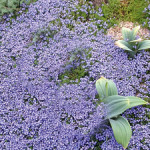
Latin name: Aethionema capitatum Height: 8-10 inches Spread (once established): 10-15 inches Bloom Season: April-May Bloom: Color soft pink
A wealth of cress-family plants proliferate throughout Asia, but few genera have as much to offer as the so- called Persian candytufts (Aethionema). this species has proven to be especially long-lived and vigorous in Colorado, offered for years by Sunscapes Rare Plant Nursery in Pueblo, Colo., a premier supplier of xeric and alpine perennials.
Turkish candytuft is actually a tiny shrub with gor- geous, silvery foliage that makes a tight dome year-round. it’s covered for many weeks with fragrant, pink, cruciform flowers. once established, this plant thrives with minimal or no supplemental water.
STINKING HELLEBORE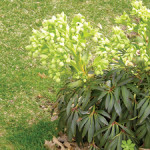
Latin name: Helleborus foetidus Height: 18-28 inches Spread (once established) 14-40 inches Bloom season: February to May Bloom color: Chartreuse and maroon
Hellebores summon up images of woodland gardens in England and the Pacific northwest, where they so lavishly grow. But I’ve found they grow every bit as vigorously in Colorado. unlike many woodlanders, hellebores seem to really like alkaline soils, and a bit more sun than you would think. As long as you provide them with some humus when you plant them, mulch with leaves or wood chips now and then, and keep them from full blasts of wind and sun, you might be surprised at how well they’ll do.
The stinking hellebore—which, BTW, doesn’t stink—has wonderfully divided evergreen foliage that’s gorgeous all year, especially in winter. When the chartreuse flowers open in March and April, the plant makes a wonderful if somewhat subtle statement that’s a nice counterpoint to the flowering shrubs and trees and bulbs blasting with bright colors around it.
PRICKLY PEAR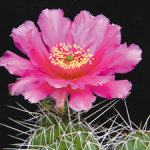
Latin name: Opuntia polyacantha ‘Red Gem’ Height 8 inches: Spread (once established) 24 inches Bloom season: May to July Bloom color: Rose-red
This remarkable, miniature prickly pear is so floriferous, so vigorous and so beautiful, it would convert even the most timorous prickly-pear hater (if you could sneak the plant into his or her garden, that is). the small pads are densely clothed with pure-white spines, and the heavenly pink flowers lavishly produce for a long season.
This plant traces its ancestry, as do so many of our local prickly pears, to Kelly Grummons of Timberline Gardens, who named and markets it. He, in turn, obtained it from Don Campbell of Grand Junction, so it’s sometimes referred to as “Campbell’s Best.” Whatever this plant’s source, it’s one of a handful of prickly pears I would never live without—and neither should you.
BLACK MOUNTAIN ONION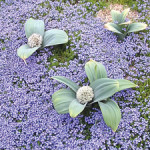
Latin name: Allium karataviense Height: 10-14 inches Spread (once established): 6-14 inches Bloom season: April-May Bloom color: Silvery bluish-purple to white
This photo shows a ball-flowered onion emerging like an extraterrestrial from a purple mat of Turkish veronica. Both plants bloom simultaneously, and make for a great partnership in the garden. Black Mountain onion is an easily located bulb that should be planted in fall, along with daffodils and tulips. I’m shocked that more people do not plant bulbs—they’re perhaps the last, great bargain in our gardening lives. What other plants can you buy that are so showy for 50 cents or less?
In the garden, this plant clumps up and improves over the years. My planting has self-sown, so I now have dozens from what was an expenditure of just a few dollars. there’s even a pure-white form of this onion available through mail order. this plant loves almost any soil you give it, as well as sun or shade.
WINECUPS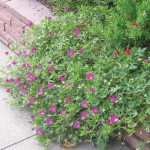
Latin name: Callirhoe involucrata Height: 3-5 inches Spread (once established): 20-45 inches Bloom season: May to autumn and early winter Bloom color: Magenta
Although a few local nurseries have offered winecups for years, this spectacular native ground cover only reached a wide audience when Plant select promoted it a decade ago. it’s still far too rarely seen, and many people think it’s a geranium because of its glossy, palmate leaves and bright magenta flowers. unlike any geranium, however, winecups is an ironclad, hardy plant that thrives on neglect and blooms all summer long through the hottest weather. once established, it needs no supplemental irrigation and laughs at drought. it also loves clay or sandy soil.
TURKISH VERONICA
Latin name: Veronica liwanensis Height: 1-2 inches Spread (once established): 14-25 inches Bloom season: April to June Bloom color: Deep blue
So far, more Turkish veronica has been sold through the Plant select program than any of its other hundred or so offerings—a great testament to this plant’s worthiness. interestingly, this remarkable evergreen ground cover, with glossy, almost succulent foliage mats, is a rare plant in nature. it spreads quickly on almost any soil type, provided it’s not too wet or shady. I’ve even grown it in one spot with no supplemental irrigation for decades. this plant is too beautiful for words when its mat is obscured beneath a sheet of cobalt flowers for weeks in spring.
 Panayoti Kelaidis is a plant aficionado, and senior curator and director of outreach at Denver Botanic Gardens.
Panayoti Kelaidis is a plant aficionado, and senior curator and director of outreach at Denver Botanic Gardens. 

